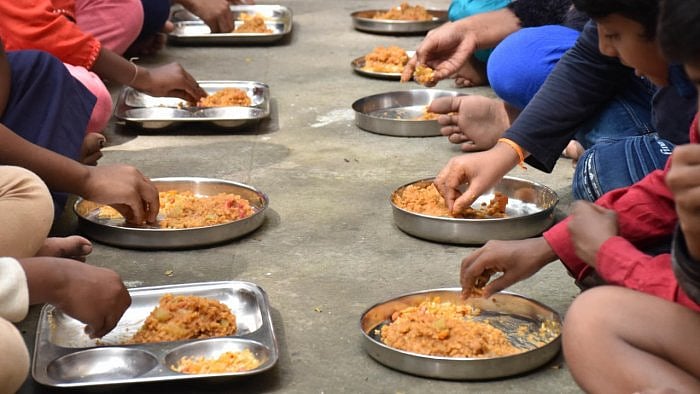
A political force which has grown strong utilising an issue not related to core socio-economic concerns may continue to neglect such concerns without damaging its vote bank. Worse, it can make tall promises on socio-economic matters and still may not deliver on any. The Narendra Modi government has exemplified precisely this with its apathy towards the mid-day meal scheme.
The Modi government asserted its commitment to children's nutrition, which was why it decided to improve the mid-day meal scheme by adding the National Scheme for PM Poshan for Bal Vatika (pre-school) students. However, in real terms, its expenditure for the mid-day meal scheme has gone down heavily during its tenure.
The matter has come to light once again as, after two years, the Centre announced a pathetically meagre hike in the cost of cooking the mid-day meal. When the cost of cooking the mid-day meal was revised in 2020, it increased from Rs 4.48 to Rs 4.97 per student for primary (first to fifth standards) and from Rs 6.71 to Rs 7.45 for upper primary (sixth to eighth standards) classes. It has been revised to Rs 5.45 per primary child and Rs 8.17 per upper primary child, an increase of 48 paise for primary and 72 paise for upper primary students.
The Union and state governments bear the cost in the 60:40 ratio. Out of Rs 5.45 for the primary child, the Union government will provide Rs 3.27 while the states will contribute Rs 2.18. For the upper primary, the contributions of the Union and the governments will be Rs 4.90 and Rs 3.27, respectively. Now, consider the cost per plate for primary children. It is just Rs 5.45. With an egg costing not less than Rs 3.5 even in remote rural areas, the amount allocated seems a cruel joke. An alternative to egg, for vegetarians, like a glass of milk, will be costlier. So, naturally, these protein-rich items cannot find their way into the plates of our unfortunate poor children.
If we move on to the macro picture, things will become more apparent and puzzling. Narendra Modi came to power in 2014, and comparing the inflation-adjusted figures of the Union government's allotment for the scheme between 2014 and 2021; we find the budget for the scheme has gone down, as Jean Dreze has pointed out, by 32.3 per cent. If you think 2021 was a Covid-19 year, the budget was slashed as schools were not open for the whole year, you are mistaken. For 2021-22, the budget estimate for mid-day meals was Rs 11,500 crore, which was lowered in the revised estimate. And for the current year (2022-23), it has been pegged at Rs 10,233.75 crore.
With the total yearly expenditure of the government being nearly Rs 40 lakh crore, the allotment for the mid-day meal scheme is a pittance, particularly if we keep in mind this is a question of nutrition for our children from poorer families. There are reports from every part of the country about the poor quality of food served, but what else is expected? Can a ten-year-old be served nutritious food at Rs 5.45?
It is an enigma how the government affords to deflate, in real terms, the allocation for nutrition when the number of students is rising each year. Is it magic that the students are being served better by allotting less money for an increasing number of heads?
However, the Union government can traverse this path without fearing an uproar being created on it by the opposition parties. If the Union government raises its contribution, the states will also have to increase their contribution. The mid-day meal scheme is an unattractive one. After all the children do not vote, no opposition-ruled state is interested in spending more on this scheme.
The mid-day meal scheme was forced upon the governments by the Supreme Court in 2001. But, it seems the governments, the Union and the state governments, never accepted it whole-heartedly. Many regional parties are more interested in going for non-productive expenditures like free bus rides for all women (most of whom do not need it) or handing money to Durga Puja organisers (most of whom have a Rs 10 lakh plus budgets).
The moral of this true story of 'new India' is that the State has orphaned the poorer children of the nation. But no one except a few social activists, is concerned because, sadly, they are not 'our' children.
(Diptendra Raychaudhuri is a journalist and author based in Kolkata)
Disclaimer: The views expressed above are the author's own. They do not necessarily reflect the views of DH.